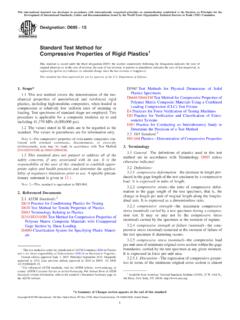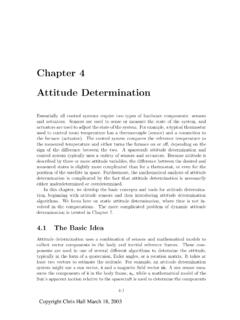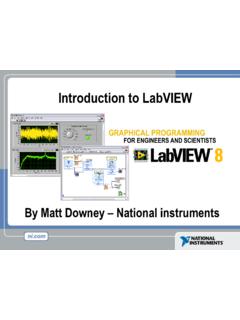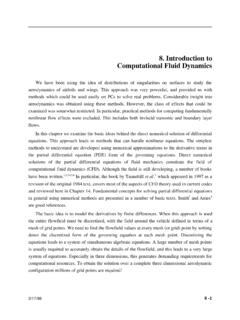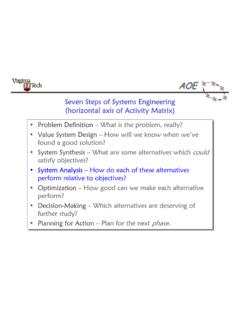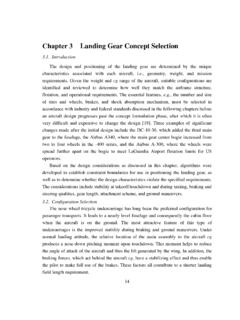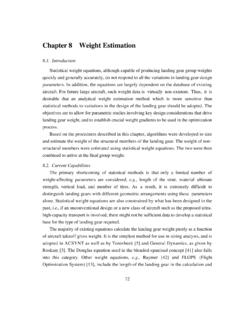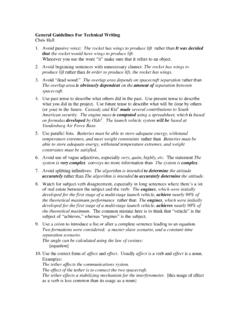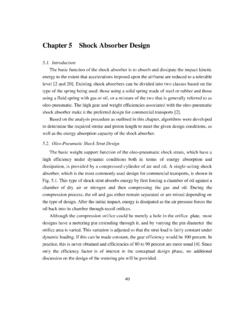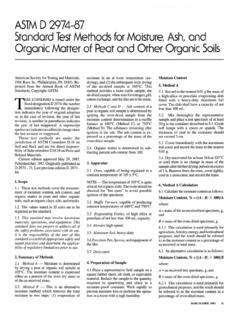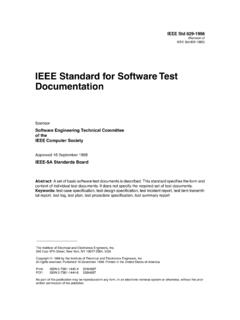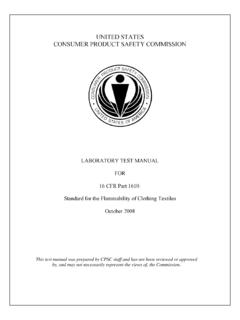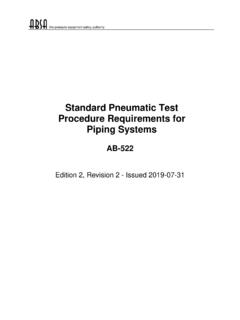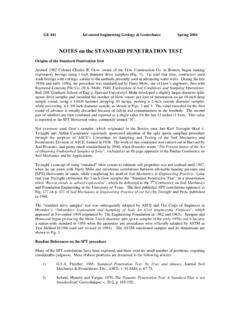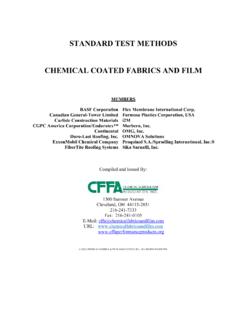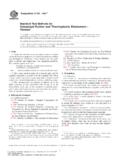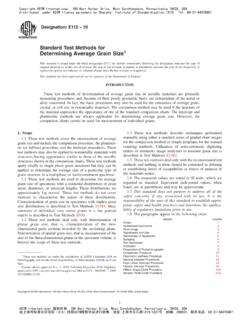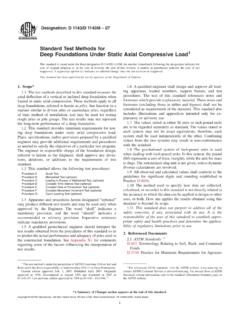Transcription of Standard Test Method for Tensile Properties of Plastics1
1 Designation: D638 14 Standard Test Method forTensile Properties of Plastics1 This Standard is issued under the fixed designation D638; the number immediately following the designation indicates the year oforiginal adoption or, in the case of revision, the year of last revision. A number in parentheses indicates the year of last reapproval. Asuperscript epsilon ( ) indicates an editorial change since the last revision or Standard has been approved for use by agencies of the Department of Scope* This test Method covers the determination of the tensileproperties of unreinforced and reinforced plastics in the formof Standard dumbbell-shaped test specimens when tested underdefined conditions of pretreatment, temperature, humidity, andtesting machine This test Method is applicable for testing materials ofany thickness up to 14 mm ( in.)
2 However, for testingspecimens in the form of thin sheeting, including film less mm ( in.) in thickness, ASTM standardD882is thepreferred test Method . Materials with a thickness greater than14 mm ( in.) shall be reduced by This test Method includes the option of determiningPoisson s ratio at room This Standard and ISO 527-1 address the same subject matter,but differ in technical This test Method is not intended to cover precise physicalprocedures. It is recognized that the constant rate of crosshead movementtype of test leaves much to be desired from a theoretical standpoint, thatwide differences may exist between rate of crosshead movement and rateof strain between gage marks on the specimen, and that the testing speedsspecified disguise important effects characteristic of materials in theplastic state. Further, it is realized that variations in the thicknesses of testspecimens, which are permitted by these procedures, produce variations inthe surface-volume ratios of such specimens, and that these variations mayinfluence the test results.
3 Hence, where directly comparable results aredesired, all samples should be of equal thickness. Special additional testsshould be used where more precise physical data are This test Method may be used for testing phenolic moldedresin or laminated materials. However, where these materials are used aselectrical insulation, such materials should be tested in accordance withTest MethodsD229and Test For Tensile Properties of resin-matrix composites reinforcedwith oriented continuous or discontinuous high modulus >20-GPa(> 106-psi) fibers, tests shall be made in accordance with TestMethodD3039 Test data obtained by this test Method have been foundto be useful in engineering design. However, it is important toconsider the precautions and limitations of this Method foundinNote 2and Section4before considering these data forengineering The values stated in SI units are to be regarded asstandard.
4 The values given in parentheses are for Standard does not purport to address all of thesafety concerns, if any, associated with its use. It is theresponsibility of the user of this Standard to establish appro-priate safety and health practices and determine the applica-bility of regulatory limitations prior to Referenced standards :2D229 Test Methods for Rigid Sheet and Plate MaterialsUsed for Electrical InsulationD412 Test Methods for Vulcanized Rubber and Thermoplas-tic Elastomers TensionD618 Practice for Conditioning Plastics for TestingD651 Test Method for Test for Tensile Strength of MoldedElectrical Insulating Materials(Withdrawn 1989)3D882 Test Method for Tensile Properties of Thin PlasticSheetingD883 Terminology Relating to PlasticsD1822 Test Method for Tensile -Impact Energy to BreakPlastics and Electrical Insulating MaterialsD3039/D3039 MTest Method for Tensile Properties of Poly-mer Matrix Composite MaterialsD4000 Classification System for Specifying Plastic Materi-alsD4066 Classification System for Nylon Injection and Extru-sion Materials (PA)
5 D5947 Test Methods for Physical Dimensions of SolidPlastics SpecimensE4 Practices for Force Verification of Testing Machines1 This test Method is under the jurisdiction of ASTM CommitteeD20on Plasticsand is the direct responsibility of Mechanical edition approved Dec. 15, 2014. Published March 2015. Originallyapproved in 1941. Last previous edition approved in 2010 as D638 - 10. referenced ASTM standards , visit the ASTM website, , orcontact ASTM Customer Service at ForAnnual Book of ASTMS tandardsvolume information, refer to the Standard s Document Summary page onthe ASTM last approved version of this historical Standard is referenced *A Summary of Changes section appears at the end of this standardCopyright ASTM International, 100 Barr Harbor Drive, PO Box C700, West Conshohocken, PA 19428-2959. United StatesThis international Standard was developed in accordance with internationally recognized principles on standardization established in the Decision on Principles for theDevelopment of International standards , Guides and Recommendations issued by the World Trade Organization Technical Barriers to Trade (TBT) E83 Practice for Verification and Classification of Exten-someter SystemsE132 Test Method for Poisson s Ratio at Room TemperatureE691 Practice for Conducting an Interlaboratory Study toDetermine the Precision of a Test Standard :4 ISO 527-1 Determination of Tensile Properties3.
6 Definitions of terms applying to this testmethod appear in TerminologyD883andAnnex Significance and This test Method is designed to produce Tensile propertydata for the control and specification of plastic materials. Thesedata are also useful for qualitative characterization and forresearch and Some material specifications that require the use of thistest Method , but with some procedural modifications that takeprecedence when adhering to the specification. Therefore, it isadvisable to refer to that material specification before using thistest Method . Table 1 in ClassificationD4000lists the ASTM materials standards that currently Tensile Properties are known to vary with specimenpreparation and with speed and environment of , where precise comparative results are desired,these factors must be carefully It is realized that a material cannot be tested without alsotesting the Method of preparation of that material.
7 Hence, whencomparative tests of materials per se are desired, exercise greatcare to ensure that all samples are prepared in exactly the sameway, unless the test is to include the effects of samplepreparation. Similarly, for referee purposes or comparisonswithin any given series of specimens, care shall be taken tosecure the maximum degree of uniformity in details ofpreparation, treatment, and Tensile Properties provide useful data for plastics engi-neering design purposes. However, because of the high degreeof sensitivity exhibited by many plastics to rate of straining andenvironmental conditions, data obtained by this test methodcannot be considered valid for applications involving load-timescales or environments widely different from those of this testmethod. In cases of such dissimilarity, no reliable estimation ofthe limit of usefulness can be made for most plastics.
8 Thissensitivity to rate of straining and environment necessitatestesting over a broad load-time scale (including impact andcreep) and range of environmental conditions if Tensile prop-erties are to suffice for engineering design Since the existence of a true elastic limit in plastics (as inmany other organic materials and in many metals) is debatable, thepropriety of applying the term elastic modulus in its quoted, generallyaccepted definition to describe the stiffness or rigidity of a plastic hasbeen seriously questioned. The exact stress-strain characteristics of plasticmaterials are highly dependent on such factors as rate of application ofstress, temperature, previous history of specimen, etc. However, stress-strain curves for plastics, determined as described in this test Method ,almost always show a linear region at low stresses, and a straight linedrawn tangent to this portion of the curve permits calculation of an elasticmodulus of the usually defined type.
9 Such a constant is useful if itsarbitrary nature and dependence on time, temperature, and similar factorsare Machine A testing machine of the constant-rate-of-crosshead-movement type and comprising essentiallythe Member A fixed or essentially stationarymember carrying one Member A movable member carrying asecond Grips for holding the test specimen betweenthe fixed member and the movable member of the testingmachine can be either the fixed or self-aligning Fixed grips are rigidly attached to the fixed andmovable members of the testing machine. When this type ofgrip is used take extreme care to ensure that the test specimenis inserted and clamped so that the long axis of the testspecimen coincides with the direction of pull through thecenter line of the grip Self-aligning grips are attached to the fixed andmovable members of the testing machine in such a manner thatthey will move freely into alignment as soon as any load isapplied so that the long axis of the test specimen will coincidewith the direction of the applied pull through the center line ofthe grip assembly.
10 Align the specimens as perfectly as possiblewith the direction of pull so that no rotary motion that mayinduce slippage will occur in the grips; there is a limit to theamount of misalignment self-aligning grips will The test specimen shall be held in such a way thatslippage relative to the grips is prevented insofar as surfaces that are deeply scored or serrated with a patternsimilar to those of a coarse single-cut file, serrations about ( in.) apart and about mm ( in.) deep, havebeen found satisfactory for most thermoplastics. Finer serra-tions have been found to be more satisfactory for harderplastics, such as the thermosetting materials. It is important thatthe serrations be kept clean and sharp. Should breaking in thegrips occur, even when deep serrations or abraded specimensurfaces are used, other techniques shall be used.
